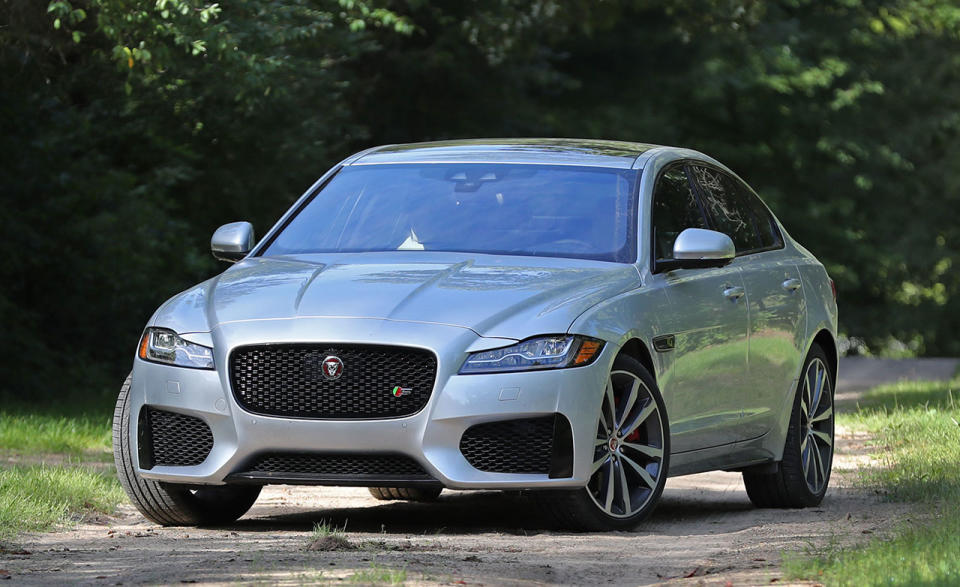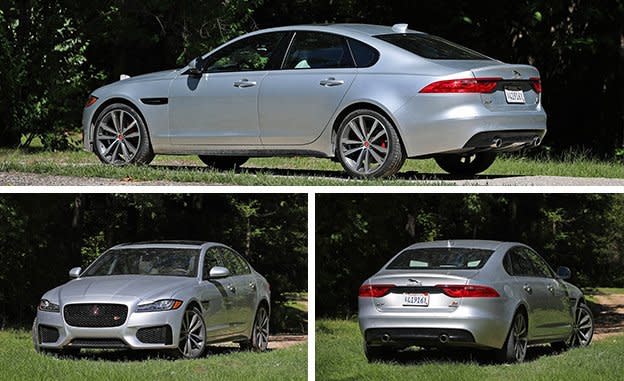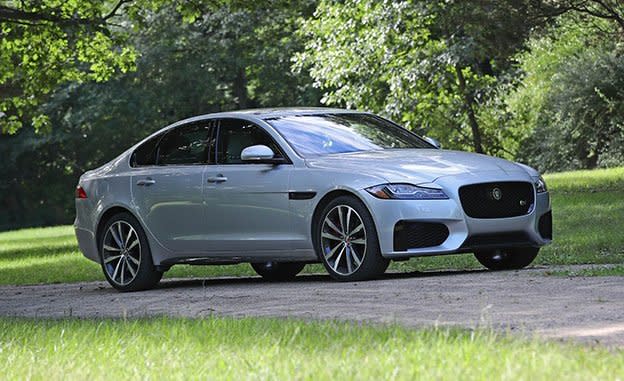2017 Jaguar XF S AWD

Jaguar no doubt disagrees, but the best perk of driving one of its cars is not seeing another one. There’s too much country for Jaguars to be as commonplace as Mercedes-Benzes or BMWs, each of which sells about 20 times as many vehicles in America as the British automaker scrapes together in one year. That may change some as the F-Pace SUV and XE compact sedan gain momentum, but right now Jaguar remains very much a boutique brand. This is a company that fielded a three-car lineup just four years ago, all of them rear-wheel-drive V-8s. So even if the XF’s sleek profile looks familiar, it’s an uncommon sight for most people.
Feeling special, we have now tested the top-of-the-line XF S. When this second-generation mid-size sedan debuted last fall, we reviewed a rear-wheel-drive 35t R-Sport with the XF’s then base engine, the 3.0-liter supercharged V-6 found across Jaguar’s lineup. For 2017, the XF adds a new starter trim called the 20d, which comes with a turbocharged 2.0-liter diesel inline-four shared with the XE and, soon, the F-Pace. Given the considerable dip in oomph, Jaguar discounts the diesel by a couple of thousand dollars versus the 340-hp V-6.

Our all-wheel-drive S is as sporty as the XF gets before the upcoming high-performance SVR model makes it truly nasty. For $2050, a couple of extra mods turn the 35t R-Sport into an S. Software tweaks the V-6 to 380 horsepower and 339 lb-ft of torque (up 7 lb-ft), while adaptive dampers collaborate with larger 20-inch wheels. Aesthetically, the car gets bigger scoops, red brake calipers, and contrasting gloss black trim. Jaguar also fitted our example with $11,180 in options, bringing our as-tested total to a hefty $77,875.
Marginally Quicker
Much in the way that a base F-type coupe delivers 98 percent of the F-type S, the XF S is separated from its lesser sibling by the thinnest of margins—and sometimes, it’s not an improvement. Compared with the similarly option-laden R-Sport, the S was 0.1 second slower to 60 mph at 5.1 seconds, but a tenth quicker in the quarter-mile with a 2-mph-higher trap speed; it was just a skosh (0.01 g) grippier on the skidpad. Braking was actually worse, requiring 10 extra feet to stop from 70 mph, although it should be noted that more than a few Car and Driver editors had flogged these rotors on our test loop before it headed to the track. We found other disadvantages. All-wheel drive fattened this kitty by 116 pounds (the S is available with rear-drive for $3000 less), plus the S model wore the same Pirelli Cinturato P7 All Season tires as the R-Sport. Summer tires are not yet on the official option list, even though you can get them on the F-Pace SUV. It’s clear where Jaguar feels its bread will be buttered.
The S really kicks in its 40 additional ponies beyond 80 mph, or the illegal zone in most of America. From a standing start to 120 mph, the gap between it and the R-Sport widens to nearly a full second. In either car, the V-6 is smooth, eager to pull, and quiet, with no supercharger whine or coarseness as it thrusts the XF toward the next curve. At legal road speeds, the two cars feel the same, and the heavier, more powerful all-wheel-drive version didn’t even hit our gasoline budget any harder—both the R-Sport and S models returned 19 mpg in our tests, though this car’s configuration scores 2 mpg worse (28 versus 30 mpg) in EPA highway ratings. Even the exhaust note is just as muted in the S—too much so for this car’s character. The F-Pace S sounds brawnier and way louder. At full throttle with the XF S, with Sport shifting and Dynamic mode both engaged, we might have been hurtling forward in a Camry for all our ears knew. When a four-cylinder Audi TTS or Mercedes SLC300 barks with more authority than a six-cylinder Jaguar, something’s amiss. Turn that S up, Coventry.

Grace at a Rapid Pace
But don’t mess with the chassis, which is beautifully balanced and predictable. The Jaguar’s thick, three-spoke steering wheel piles on that confidence as a Goldilocks example of how to tune electric power assist. Around town, it’s light but not overly quick. As speed builds, weight increases and just enough road feel reaches the steering-wheel rim without the car becoming overly chatty in the mold of a hypernervous sports car. In Dynamic mode, which sharpens steering response even more, it still feels natural. Jaguar’s Dynamic mode can individually toggle the throttle, transmission, steering, and suspension between Normal and Sport settings, although the default tune is so spot-on that we didn’t fiddle with it most of the time.
Suspension compliance is another strong suit, just as it was in the previous-generation XF. The adaptive dampers don’t transform the S from the standard fixed setup, yet neither do they punish the ride. In any mode, the XF S calmly chews up corners with a deft balance of body control and suspension compliance. As in nearly all cars with the ZF eight-speed automatic transmission, the XF S shifts imperceptibly even when downshifting during aggressive braking.
Vanity is Jaguar’s strongest appeal, and the XF S is such a handsome devil that we couldn’t resist checking ourselves out while driving past Ann Arbor’s reflective storefronts. At some angles, particularly from the rear-three-quarter view, this XF is more square and conservative than the first-gen car. That same design carries over inside, with an upright center stack and plain, flat rubberized trim on the passenger-side dash. The curved cowl connecting the doors, along with splashes of aluminum trim and a few magic tricks—retracting front air vents, a rising rotary shifter, and touch-sensitive map lights—brighten the otherwise serious demeanor. All in all, the XF’s design will age well alongside, presumably, its owner.

Beautiful Inside, Despite Electrons Run Amok
The leather sport seats are supportive and include adjustable thigh and side bolsters, but they’re not as cushy as the thrones found in the Mercedes-Benz E-class. With the Comfort and Convenience package ($2100) found on our test car, the seats can heat or cool the seatback and cushion separately, so you keep your dress shirt dry without having chilled air applied from below. Our car was fully digitized with Jaguar’s 10.2-inch touchscreen and a 12.3-inch reconfigurable instrument panel ($3200, part of the Technology package) that can replace the gauges with a full-screen map, among other feats.
The infotainment system could be good. But the random lag and occasionally locked-out controls—sorry, we’d like to adjust the stereo volume while reverse gear is engaged?—shows it’s clearly unfinished. There’s no voice control for navigation, but Jaguar promises in-car Wi-Fi, live traffic, and other streaming services; we didn’t access those, so we can’t say if they’re more reliable and responsive than the other system features. It’s otherwise a pretty logical and straightforward place to poke around. The customizable home menus and layouts are color coded and intuitive, the screen accepts swipe and pinch gestures, and when it’s having a good day, everything runs quickly. We see a software update in the XF’s near future. If not, Jaguar dealers will be processing lots of claims over the car’s five-year/60,000-mile warranty.

Other tech works without a hitch, like the adaptive cruise control in the Driver Assistance package ($3200), which also brings 360-degree cameras, traffic-sign recognition, and automatic parallel and perpendicular parking. Blind-spot monitoring—which signals a separate, rapid-flash alert for fast-approaching vehicles—is standard, as are forward collision alert, automated emergency braking, lane-keeping assist, and a driver-attention monitor. None of these features operates in semi-autonomous mode, however. A razor-sharp multicolor head-up display ($990), carbon-fiber trim ($790), more gloss-black exterior trim ($350), and Rhodium Silver metallic paint ($550) rounded out our car’s extras. It’s possible to see $83,000 if you also tack on special paint ($1500), upgraded wheels ($1000), a heated windshield with heated washer jets ($375), and select the Luxury Interior package ($2800) for the faux-suede headliner, selectable ambient lighting, four-zone climate control, and rear sun blinds.
In essence, the XF S proved to be more of an appearance package than a performance upgrade. When we say this car deserves more power, it’s a testament to how much Jaguar sweated over the XF’s superb chassis and suspension. Something rated between this car’s 380-hp and the 550-hp V-8 that powers the Range Rover Sport SVR could fill that gap nicely. Regardless, the XF S is a luxurious driver’s car with plenty of cachet, and one you likely won’t see twice on the same block.
Specifications >
VEHICLE TYPE: front-engine, 4-wheel-drive, 5-passenger, 4-door sedan
PRICE AS TESTED: $77,875 (base price: $66,695)
ENGINE TYPE: supercharged and intercooled DOHC 24-valve V-6, aluminum block and heads, direct fuel injection
Displacement: 183 cu in, 2995 cc
Power: 380 hp @ 6500 rpm
Torque: 339 lb-ft @ 3500 rpm
TRANSMISSION: 8-speed automatic with manual shifting mode
DIMENSIONS:
Wheelbase: 116.5 in
Length: 195.0 in
Width: 74.0 in Height: 57.4 in
Passenger volume: 100 cu ft
Cargo volume: 19 cu ft
Curb weight: 4243 lb
C/D TEST RESULTS:
Zero to 60 mph: 5.1 sec
Zero to 100 mph: 12.2 sec
Zero to 120 mph: 18.0 sec
Rolling start, 5–60 mph: 5.6 sec
Top gear, 30–50 mph: 3.0 sec
Top gear, 50–70 mph: 4.1 sec
Standing ¼-mile: 13.5 sec @ 105 mph
Top speed (governor limited): 128 mph
Braking, 70–0 mph: 180 ft
Roadholding, 300-ft-dia skidpad: 0.87 g
FUEL ECONOMY:
EPA city/highway driving: 20/28 mpg
C/D observed: 19 mpg

 Yahoo Autos
Yahoo Autos 